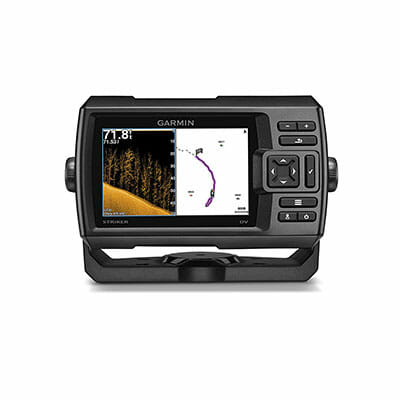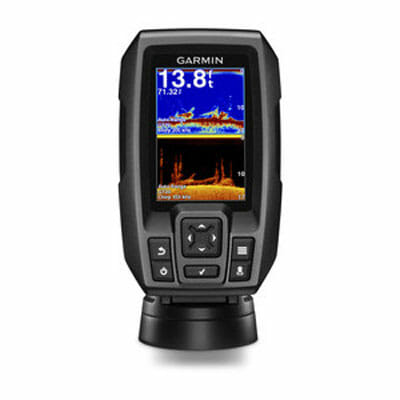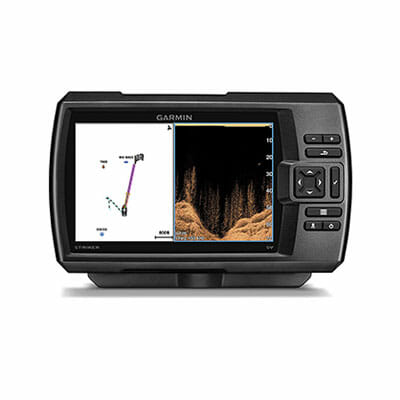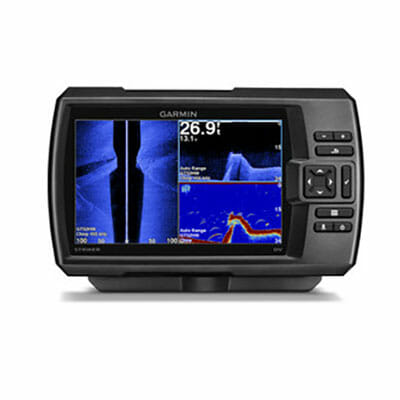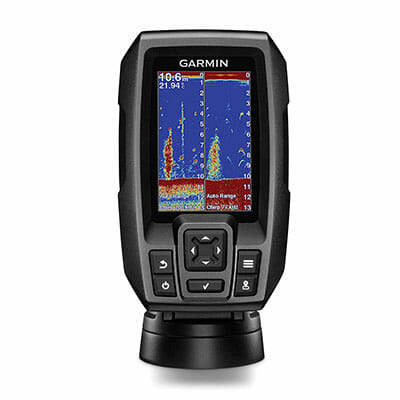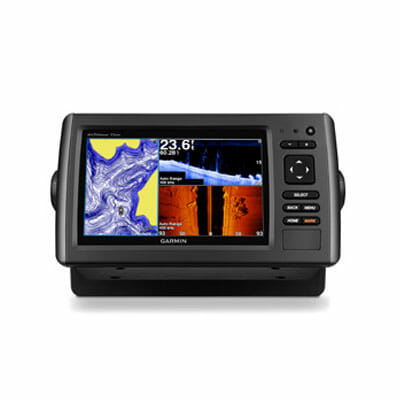Garmin Striker 5dv is an affordable fish finder/GPS combo with an extremely powerful dual-frequency sonar equipped with the CHIRP technology for both 2D and DownVü, the GT20-TM transducer, and basic GPS.

Garmin is one of the biggest players (if not THE biggest player) on the fish finding market thanks to the international renown of its GPS units and technologies. Apart from built-in high-precision GPS and chartplotting functionalities, Garmin fish finders come with top-tier CHIRP sonars and CHIRP scanning capabilities.
Premium Garmin units also have integrated Wi-Fi and other relevant connectivity options and grant you access to the ActiveCaptain app. You will be able to use your favorite maps and charts since Garmin fish finders are mostly compatible with all the major packages available. Garmin devices come with all the traditional sonar features you can think of, including Split Screen (Zoom), Ultrascroll, Fish ID (+), AutoGain Tech, A-scope, Adjustable depth line, BotomLock, and more.
Speaking of scanning sonars, premium Garmin fish finders boast ClearVü and SideVü technologies that provide you with nearly photographic images of what lies (and passes) underneath your vessel as well as crisp side readings. The traditional CHIRP sonar, on the other hand, captures fish arches with remarkable target separation.
In recent years, Garmin improved the display quality of its units as well, so you can expect to see larger HD screens with incredible backlighting that allow you to observe readings perfectly regardless of the weather and/or time of day. Many of the units have a Split Screen feature that enables you to observe up to 4 panels at the same time.
Garmin fish finders usually come with a transducer, but default models cannot support the full capacity of the main unit in most cases, especially if the unit can hit lower frequencies (50 kHz, for example). However, you can always upgrade any component by purchasing superior models on the official Garmin website. All provided transducers have temperature sensors and can keep track of your current speed.
Most Garmin devices have an IP-X7 waterproof rating, which means you do not have to worry about heavy rain or accidental splashes. This is especially important since most of the units do not feature protective covers.
Garmin Fish Finders Series
Although fish finders are not its primary focus, Garmin already has a couple of worldwide famous series of products, including:
Striker Series – Striker fish finders feature built-in CHIRP technology as well as high-precision GPS. They are primarily designed to deliver excellent sonar performance at budget-friendly prices. The units are ideal for coastal and inland fishers who navigate their vessels by sight and do not really have any use for chartplotters and map packages. Therefore, Garmin Striker fish finders are not compatible with any maps or charts. All units come with mounts and transducers, have good screens, and are very easy to operate even if you are wearing gloves. The CHIRP technology allows for much better target separation and all units except for Striker 4 feature DownVü Imaging, which provides photo-like image quality. The series contains 3 units with 3.5”, 5”, and 7” screen diagonals, with the largest model also being available with SideVü. All units are capable of measuring the water temperature and your current speed.
Garmin Fish Finders Buyer’s Guide
Even when talking about a single brand, there are still fish finders that excel in some aspects of fishing while underperforming in others. This is why it is so important to choose the best Garmin fish finder for your specific needs and preferences. With that in mind, let us go over our top picks for certain types of fishing as well as different vessels, depths, and other fishing conditions.
Fishing Type
Here are our recommendations based on the type of fishing activity:
Angling with a rod – If you are fishing with an angle, there are many factors that will determine the best Garmin fish finder for you. For example, you will not be using the same device if you are bank fishing and if you decide to rent a fishing vessel. The same goes for angling in freshwater and angling in saltwater. Bottom line, even though amateurs usually think that “angling” is enough information to identify the top unit for the job, this is simply not the case. You will need to complement your chosen fishing style with more information in order to get the right device. Having said that, utilizing the broadest possible criteria, we can say that Garmin Striker 4 is ideal for beginner anglers who have not had much contact with fish finders while Garmin Striker 4cv represents a bit more advanced budget-friendly option.
Line fishing (droplining, jigging, handlining, slabbing, longlining, trotlining) – Line fishing is basically angling without a rod, so everything we said in the previous section applies here as well. Garmin Striker 4 and 4cv are ideal for beginners while more experienced fishers can use Garmin Striker 7dv and 7sv, depending on their particular needs.
Trolling – When it comes to ideal fish finders for trolling, you want to look for models with good transducers unless you wish to buy a transducer separately. Your transducer needs to be able to provide you with clear imaging while the vessel is in motion, so units like Garmin Striker 4 that come with the Ultrascroll feature represent the best choice. This particular device will allow you to receive perfect image quality at speeds up to 50 MPH.
Ice fishing – When it comes to ice fishing, you first want to make sure your chosen device can operate in harsh weather conditions. On top of that, it needs to have all the features required for this very specific task. Therefore, units like Garmin Striker 5dv are excellent examples of fish finders that will not let you down in ice fishing scenarios.
Casual/professional fishing – For casual fishers or absolute beginners, we recommend going with Garmin Striker 4. It is the best introductory unit with all the essential features but without any complicated functions that might cause confusion or that are simply not needed for casual fishing. On the other hand, professional fishers and tournament participants will get the most value out of Garmin Striker 7sv. This model is compatible with all fishing vessels and upgrading the default transducer will greatly increase its depth capabilities.
The Size Of Your Vessel
Your choice of vessel largely determines the ideal unit for your fishing trips. In general, if you are an owner, you can simply look at the best units for your preferred type of fishing without any restrictions. On the other hand, if you rely on rentals, you want a simple and portable device that does not require a complicated installation process in order to function properly. Having said that, let us take a look at our recommendations:
Kayaks, canoes, small boats – For these types of vessels, you want small, lightweight, and portable devices; trying to fit a huge fish finder with a 12″ screen inside a kayak is anything but practical and comfortable. We are talking about units with smaller screens, including Garmin Striker 4, 4cv, 5dv, and similar devices. If you are an owner, you will be happy to learn these fish finders are also very easy to install using the provided mounts or purchasing additional accessories.
Medium-to-large boats – More room to work with opens up many more options, including top-tier tournament-oriented devices like Garmin 7sv. You can also afford to pick units that include a bit more complex installation process. As you can see, the only factors of interest here are the size of the boat and whether your own or rent. Contrary to popular belief, the actual type of your boat is not that relevant. In other words, it does not make any difference if you own a skiff, a pontoon or a utility boat; as long as they are in a similar size category, you can use one fish finder on all of them.
Overall Depth
The overall reach of your fish finder will determine your potential fishing spots. Devices with deeper penetration will allow you to venture off-shore while weaker units will severely limit your choice of locations. Keep in mind that the stated max depth should not be taken at face value since it can be affected by things like saltwater, depth composition, underwater vegetation, and many other factors. Let us now go over some of our recommendations:
Inland fishing – Even though it has a pretty decent reach in freshwater (1,600ft), Garmin Striker 4 lacks the necessary features for a serious off-shore fish finder. On top of this, its maximum range in saltwater is 750ft. That is why we definitely recommend this unit as a perfect budget-friendly option for coastal and inland expeditions.
Off-shore fishing – Off-shore fishing trips require powerful fish finders with top-tier sonar features and transducers capable of covering lower sonar frequencies required for deeper water penetration. Our first recommended model is Garmin Striker 7dv with an overall reach of 2,300ft in freshwater and 1,100ft in saltwater. The provided GT20-TM 4-pin transducer is capable of covering 77/200 kHz for 2D and 455/800 kHz for dv. The unit itself can also hit 50 kHz if you upgrade it with GT22 or GT32, for example. Garmin Striker 7sv can reach the same depths if you decide to replace the provided transducer with a more advanced model. Finally, the same thing goes for Garmin echoMAP Plus 73sv.
Whether you are fishing in fresh or saltwater does not make too much of a difference in terms of picking a fish finder with better depth penetration. In other words, more powerful main units and transducers will reach further in both fresh and saltwater.
GPS Functionality
High-sensitivity GPS and excellent support for all the major maps and charts are the main strengths of Garmin fish finders. In other words, if you are looking for a reliable fish finder/GPS combo, Garmin should definitely be at the top of your list.
We recommend taking a look at Garmin echoMAP Plus 73sv. It comes with the US LakeVü charts primarily intended for inland fishing and it can also be upgraded with LakeVü HD Ultra. In case your lake is not covered, there is also the QuickDraw Contours feature as well as the SailAssist functionality. The echoMAP Plus series is also famous for its excellent chartplotting capabilities with 5,000 waypoints, 100 routes, and up to 50,000 tracks.
If you are solely interested in basic GPS functionality with up to 5,000 waypoints at your disposal, we recommend units like Garmin Striker 7sv, 7dv, 5dv, etc. Note that the Striker series units are not compatible with any maps and charts packages, which makes them much more budget-friendly.
Bottom Line
As already mentioned in this overview of Garmin fish finders and their features and functionalities, Garmin is primarily known for its top-quality, high-precision GPS modules and compatibility with major charts and maps packages. However, this does not mean it falls behind when it comes to other important fish-finding aspects!
All the units we recommended here come with high-quality displays, sonars, and other important components and they feature a rugged design with an IP-X7 waterproof rating as well as numerous traditional sonar functions. Granted, the provided transducers are usually not capable of covering the full potential of the main unit, but there are numerous potential upgrades available and they are actually not that expensive at all.
We can safely conclude that Garmin fish finders cover every personal need and preference regardless of your fishing style, choice of vessels, favorite fishing conditions, and all other relevant factors.
Garmin Striker 4cv is a compact and budget-friendly unit primarily designed for smaller vessels like kayaks and canoes, but it can be used on larger fishing boats as well. Learn more about it in this honest review.
Garmin 7dv is a part of the famous Striker Series launched in 2016 with extraordinary sensor capabilities and a wide variety of implemented features. Read more about the device in this detailed review.
Garmin Striker 7sv comes with impressive sonar capabilities (standard CHIRP plus ClearVü and SideVü), but its navigational functionality is far from ideal. Read more about this unit in our unbiased review.
Garmin Striker 4 is one of the smallest and most affordable fish finder/GPS combos that comes with a dual-frequency CHIRP sonar, which makes it ideal for casual kayak or canoe fishing trips.
Garmin echoMAP Plus 73sv is a customizable fish finder/chartplotter that comes with 2D CHIRP, sv, and cv sonars, includes a wide range of useful features, and is compatible with the Panoptix sonar and Active Captain app.
